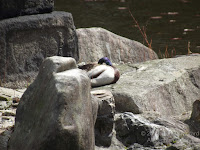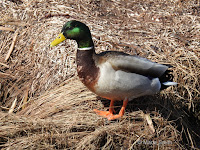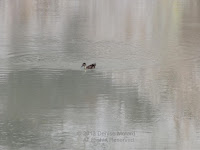MALLARD
MALLARD (Anas platyrhynchos) – (See images below)
DESCRIPTION: The Mallard is a medium sized dabbling duck about 2 inches (60 cm) long. Sexes are very different, with the drake (male) having an iridescent green head with a white band at the base of the neck, grey wings and underside and mainly brown back, and a yellow bill. Females are mainly mottled brown with a black to orange bill. Both sexes have bright blue speculum feathers edged with white. The legs and feet in both sexes are orange.
VOICE: https://www.xeno-canto.org/species/Anas-platyrhynchos
NAME: The English name ‘Mallard’ comes from Old French and refers to a ‘male’ and the suffix ‘ard’ refers to ‘bold’ and ‘hardy’ As for the Latin genus name ‘Anas’, it means ‘duck’. The Latin species name ‘platyrhynchos’ comes from ancient Greek and means ‘broad beak’.
HABITAT: As a dabbling duck, this species can be found in shallow wetlands.
DIET: Vegetation and invertebrates.
NESTING: The nest is built on the ground in a camouflaged area, and can be far away from water. The number of eggs laid varies from 5 to 15.
DISTRIBUTION: The mallard is widespread across mainly the northern hemisphere. It has also been introduced as a game bird in many other parts of the world, for example New Zealand and Hawaii (where it interbreeds with the endangered Hawaiian Duck). The mallards will migrate partially from the northernmost areas of their range, unless fed by humans.
DISTRIBUTION MAP: https://en.wikipedia.org/wiki/Mallard#/media/File:Anas_platyrhynchos_distribution_map.png
ON PEI: The Mallard is common on Prince Edward Island and a year-round resident.
CONSERVATION: The mallard is one of the most abundant duck species worldwide and as a generalist in terms of habitat and food, it has adapted well to many different environments.
NOTES: Most domestic ducks were bred from mallards. They have well adapted to the human environment and some are tame enough to accept food handouts. Thanks to their malleable genetic makeup, they interbreed easily with native duck species, thus causing concern about the latter. Identification can be difficult for the female as it is similar to that of other duck species, such as the Mottled Duck.
SIMILAR SPECIES: Hawaiian Duck, Mottled Duck
REFERENCES: https://en.wikipedia.org/wiki/Mallard
https://www.allaboutbirds.org/guide/Mallard/id
https://www.audubon.org/field-guide/bird/mallard
https://www.ducks.ca/species/mallard/
http://birdweb.org/Birdweb/bird/mallard
http://www.arkive.org/mallard/anas-platyrhynchos/
A photo below of a mallard female was seen on a pond at Waiotapu in the Rotorua area in New Zealand, an active geothermal area with ponds of different colors depending on the minerals found in the water. The water can also be quite hot, so it was surprising to find a live bird in that environment.
Here are videos below of mallards walking on an icy river and swimming in it (Charlottetown, Prince Edward Island) in the winter:
This video below shows Ring-billed gulls in addition to the mallards on that river.
DESCRIPTION: The Mallard is a medium sized dabbling duck about 2 inches (60 cm) long. Sexes are very different, with the drake (male) having an iridescent green head with a white band at the base of the neck, grey wings and underside and mainly brown back, and a yellow bill. Females are mainly mottled brown with a black to orange bill. Both sexes have bright blue speculum feathers edged with white. The legs and feet in both sexes are orange.
VOICE: https://www.xeno-canto.org/species/Anas-platyrhynchos
NAME: The English name ‘Mallard’ comes from Old French and refers to a ‘male’ and the suffix ‘ard’ refers to ‘bold’ and ‘hardy’ As for the Latin genus name ‘Anas’, it means ‘duck’. The Latin species name ‘platyrhynchos’ comes from ancient Greek and means ‘broad beak’.
HABITAT: As a dabbling duck, this species can be found in shallow wetlands.
DIET: Vegetation and invertebrates.
NESTING: The nest is built on the ground in a camouflaged area, and can be far away from water. The number of eggs laid varies from 5 to 15.
DISTRIBUTION: The mallard is widespread across mainly the northern hemisphere. It has also been introduced as a game bird in many other parts of the world, for example New Zealand and Hawaii (where it interbreeds with the endangered Hawaiian Duck). The mallards will migrate partially from the northernmost areas of their range, unless fed by humans.
DISTRIBUTION MAP: https://en.wikipedia.org/wiki/Mallard#/media/File:Anas_platyrhynchos_distribution_map.png
ON PEI: The Mallard is common on Prince Edward Island and a year-round resident.
CONSERVATION: The mallard is one of the most abundant duck species worldwide and as a generalist in terms of habitat and food, it has adapted well to many different environments.
NOTES: Most domestic ducks were bred from mallards. They have well adapted to the human environment and some are tame enough to accept food handouts. Thanks to their malleable genetic makeup, they interbreed easily with native duck species, thus causing concern about the latter. Identification can be difficult for the female as it is similar to that of other duck species, such as the Mottled Duck.
SIMILAR SPECIES: Hawaiian Duck, Mottled Duck
REFERENCES: https://en.wikipedia.org/wiki/Mallard
https://www.allaboutbirds.org/guide/Mallard/id
https://www.audubon.org/field-guide/bird/mallard
https://www.ducks.ca/species/mallard/
http://birdweb.org/Birdweb/bird/mallard
http://www.arkive.org/mallard/anas-platyrhynchos/
A photo below of a mallard female was seen on a pond at Waiotapu in the Rotorua area in New Zealand, an active geothermal area with ponds of different colors depending on the minerals found in the water. The water can also be quite hot, so it was surprising to find a live bird in that environment.
 |
| Male mallard sleeping, Kyoto, Japan |
 |
| Mallards, Wellington, NZ |
 |
| Mallard drake, PEI, Canada, Marie Smith |
 |
| Mallard, Waiotopu, Rotorua, NZ |
 |
| Mallard hen with her ducklings, PEI |
 |
| Mallards, Wellington, NZ |
This video below shows Ring-billed gulls in addition to the mallards on that river.